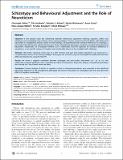Schizotypy and behavioural adjustment and the role of neuroticism
Abstract
Objective: In the present study the relationship between behavioural adjustment following cognitive conflict and schizotypy was investigated using a Stroop colour naming paradigm. Previous research has found deficits with behavioural adjustment in schizophrenia patients. Based on these findings, we hypothesized that individual differences in schizotypy, a personality trait reflecting the subclinical expression of the schizophrenia phenotype, would be associated with behavioural adjustment. Additionally, we investigated whether such a relationship would be explained by individual differences in neuroticism, a non-specific measure of negative trait emotionality known to be correlated with schizotypy. Methods: 106 healthy volunteers (mean age: 25.1, 60% females) took part. Post-conflict adjustment was measured in a computer-based version of the Stroop paradigm. Schizotypy was assessed using the Schizotypal Personality Questionnaire (SPQ) and Neuroticism using the NEO-FFI. Results: We found a negative correlation between schizotypy and post-conflict adjustment (r = −.30, p<.01); this relationship remained significant when controlling for effects of neuroticism. Regression analysis revealed that particularly the subscale No Close Friends drove the effect. Conclusion: Previous findings of deficits in cognitive control in schizophrenia patients were extended to the subclinical personality expression of the schizophrenia phenotype and found to be specific to schizotypal traits over and above the effects of negative emotionality.
Citation
Voelter , C , Strobach , T , Aichert , D S , Wöstmann , N , Costa , A , Möller , H-J , Schubert , T & Ettinger , U 2012 , ' Schizotypy and behavioural adjustment and the role of neuroticism ' , PLoS One , vol. 7 , no. 2 , 30078 . https://doi.org/10.1371/journal.pone.0030078
Publication
PLoS One
Status
Peer reviewed
ISSN
1932-6203Type
Journal article
Description
This work was funded by the Deutsche Forschungsgemeinschaft (ET 31/2-1) (http://www.dfg.de/en/index.jsp).Collections
Items in the St Andrews Research Repository are protected by copyright, with all rights reserved, unless otherwise indicated.

